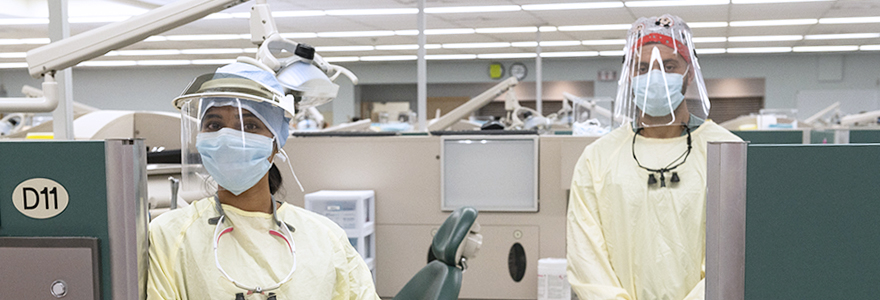News: Schulich Dentistry reinvents structure and model of clinical education to optimize learning

In order to adapt to a fall term like no other, Schulich Dentistry has reinvented the structure and model of clinical education it offers. Developed during the summer months, the Program has worked tirelessly to prepare for the realities of providing clinical education and care during a pandemic.
“Our faculty members have been delivering direct patient care safely since early June,” said Dr. Bertha Garcia, Vice Dean & Director, Schulich Dentistry. “Because of that success, we knew we could expand that model to our education programs and ensure our third and fourth year students could continue their studies in a safe manner.”
As the education teams rolled up their sleeves in June to plan the changes for the start of the fall academic term, a deep cleaning of all the clinics took place. And on September 8, dental students were met with a new structure for the clinics, increased cleaning and infection controls, as well as increased patient screening and new processes for patients to check in and out for their appointments.
The four-handed clinic model that Schulich Dentistry adopted in the fall of 2019 has been seamlessly integrated into these changes with third-year students being paired together and fourth-year students being paired together. Faculty support has been dramatically enhanced with a 1 to 3 faculty to student team ratio.
To meet public health and Royal College requirements, clinic volumes have been cut in half. Most patients will be seen in the main clinic, which is the largest of all the clinics. The paediatric and orthodontic clinics, which are contained clinical spaces, will also be operational.
The schedule for clinics and patient appointments has been adjusted to provide students with more time for cleaning and infection control between patients. The clinic will also shut down during lunch for a full cleaning to be completed by the facilities management team, who will return as the final clinic ends for another full cleaning.
A new process has been established for patient screening, and 18 screeners will be joining the clinic teams to support this critical step in the process. Patients can expect to complete a screening when their appointment is booked, and again when they arrive for their appointment. Temperature checks, masks and a staggered arrival schedule will also be in place to manage patient flow. As a final precaution, there will be limited access to the waiting rooms and a new system to alert patients to come into the clinic for their appointment and depart after their procedure has been implemented.
“We’ve been planning all summer for the academic year, we are ready and have created a resilient and flexible model which allows us to respond to a potential need for changes, said Dr. Garcia. “We’re excited to have our students back in the clinics and to support them in their learning journey.”








